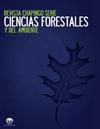Factors influencing physical dormancy and its elimination in two legumes
IF 0.6
4区 农林科学
Q3 Agricultural and Biological Sciences
Revista Chapingo Serie Ciencias Forestales Y Del Ambiente
Pub Date : 2021-01-01
DOI:10.5154/r.rchscfa.2020.06.041
引用次数: 2
Abstract
Introduction: Prosopis laevigata (Humb. & Bonpl. ex Willd.) M. C. Johnst, P. glandulosa Torr., Vachellia schaffneri (S. Watson) Seigler & Eibinger, V. pennatula (S. Watson) Seigler & Eibinger and V. farnesiana (L.) Wight & Arn. are characteristic species of semi-arid areas. Their seeds show physical dormancy and are naturally scarified by chewing, trampling, digestive tract of fauna, fire, or washing away during rains. Objective: To describe the morphology of the seed coat of three species of Vachellia and two of Prosopis, and to assess the chemical, mechanical and thermal scarification of seeds. Materials and methods: Chemical (HCl for 30, 120, 150 and 180 min), thermal (80, 100, 120 and 140 °C for 3 min) and mechanical (sanding) scarification were applied. Resistance to breaking by compression was measured. The experimental design was randomized complete blocks per species. Results and discussion: Seeds showed a layer of lignified and impermeable macrosclereids, but the aleurone layer could not be detected. Sanding allowed germination from 81.2 to 100 %. Chemical and thermal treatments showed no differences, only in the case of P. laevigata, chemical scarification for 180 min caused higher germination (72.5 %) compared to the control. Vachellia schaffneri seeds were more resistant to compression (669 N) and had more intense dormancy (0.83), while P. glandulosa had the lowest dormancy (0.42). Conclusions: Mechanical scarification was the best method to eliminate dormancy in Vachellia and Prosopis seeds.两种豆科植物生理休眠的影响因素及其消除
导读:青豆(Humb.)& Bonpl。Willd交货)。m.c.约翰,p.g andullosa Torr。, Vachellia schaffneri (S. Watson) Seigler & Eibinger, V. pennatula (S. Watson) Seigler & Eibinger和V. farnesiana (L.)wright & Arn。是半干旱地区的特有物种。它们的种子处于生理休眠状态,通过咀嚼、践踏、动物消化道、火或雨水冲走而自然受损。目的:描述三种花楸属植物和两种豆属植物种皮的形态,并对种子的化学、机械和热刻蚀作用进行评价。材料和方法:化学(HCl为30、120、150和180分钟),热(80、100、120和140°C为3分钟)和机械(砂磨)切割。测定了其抗压缩断裂性能。实验设计为每个物种随机完整区。结果与讨论:种子表面有一层木质化的不透水大胶质,但未见糊粉层。砂处理使发芽率从81.2%提高到100%。化学和热处理没有显著差异,只有化学刻蚀180 min的发芽率高于对照(72.5%)。沙夫纳种子抗压能力最强(669 N),休眠强度最高(0.83 N),而甘花种子休眠强度最低(0.42 N)。结论:机械划伤是消除水珠属和豆属种子休眠的最佳方法。
本文章由计算机程序翻译,如有差异,请以英文原文为准。
求助全文
约1分钟内获得全文
求助全文
来源期刊
CiteScore
1.20
自引率
16.70%
发文量
0
审稿时长
>12 weeks
期刊介绍:
The Revista Chapingo Serie Ciencias Forestales y del Ambiente (RCHSCFA) is a scientific journal that aims to raise awareness of high-quality research products related to forest, arid, temperate and tropical environments in the world. Since its foundation in 1994, the RCHSCFA has served as a space for scientific dissemination and discussion at a national and international level among academics, researchers, undergraduate and graduate students, forest managers and public/private entities that are interested in the forest environment.
All content published in the journal first goes through a strict triple-blind review process and is published in the following formats: Scientific Articles, Review Articles, Methodologies, Technical or Technological Notes.

 求助内容:
求助内容: 应助结果提醒方式:
应助结果提醒方式:


